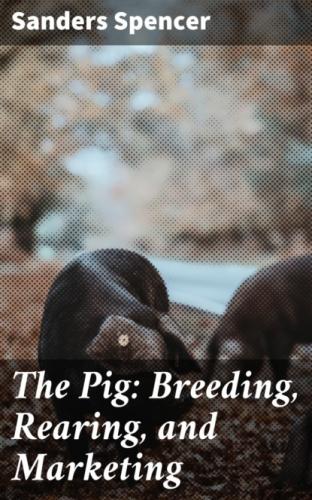Sanders Spencer
The Pig: Breeding, Rearing, and Marketing
Published by Good Press, 2021
EAN 4064066208226
Table of Contents
CHAPTER IV DENTITION AND AGE OF PIGS
CHAPTER V SELECTION OF THE BOAR
CHAPTER VI SELECTION OF THE SOW
CHAPTER VIII MATING THE YOUNG SOW
CHAPTER XI THE REARING OF YOUNG PIGS
CHAPTER XIII THE EXHIBITION OF PIGS
CHAPTER XIV PRESENT AND FUTURE PIG-KEEPING
CHAPTER XVII DISEASES OF THE PIG
CHAPTER XVIII THE CURING OF PORK
INTRODUCTION
There are few points in the breeding of stock on which a greater variation of opinion has been confidently expressed than on the origin of the domesticated pig. It has been contended that our various types had a common origin in the wild hog, and that the difference in form, colour, and character amongst the local breeds is due, in the main, to the requirements, imaginary or real, of the interested residents in the particular districts. On the other hand, it is asserted with equal confidence, and probably with the same amount of actual proof, that it would be impossible so to improve the wild hog by selection as to render it the equal of the domesticated hog. There must, therefore, have been an infusion of blood of a cultivated breed of pigs to acquire even that amount of success which was noticeable in the improved pig of a century, or less, ago. Unfortunately, for this argument, it has not been possible to obtain any information of value as to the alleged source of origin of this cultivated breed of pigs.
Again, those pigs which possess in a marked degree early maturity, fine quality of flesh, and those other characteristics of the improved pig, are so various in colour, that one cultivated breed only could not have been utilised in the general improvement.
All the ancient writers on pigs appear to have experienced the same difficulty when endeavouring to discover the sources of origin of the material which might have been used in the production of the pig which in their time was looked upon as the domesticated and improved pig of the period. This difficulty extends even to the present day. So far as is known there exists no actual proof that the domesticated hog has been evolved in any particular way other than by continued selection of those animals for breeding purposes which possessed in the greatest degree those particular qualities held in the highest estimation at the time.
Of course, the soil, climate, etc., of the district in which pigs are reared have a certain amount of influence, but this is noticeable to a much lesser extent with pigs than with horses, cattle, or sheep, since under the present system of pig-breeding the greater portion of the food used in the different districts is of a very similar character—indeed, much of it has a common origin—having been imported from abroad.
As a rule, comparatively speaking very little difference is noticeable in the development, form, and character of pigs bred in the various parts of the country, whereas with some of the other domesticated animals a very considerable change follows the removal of sheep of a pure breed from one district to another. The quality and quantity of the wool, flesh, and bone are all affected. An exactly similar effect is noticeable when horses of a particular breed are moved from one district to another. For instance, a Shire foal bred in the Fens may possess the characteristic bone, flesh, and hair, yet if it be moved into portions of the Eastern counties where the soil is of a totally different character, it will when matured have lost, to a very considerable extent, its peculiar characteristics of bone and hair. The changes wrought may be due in small measure to climate, but the predominant cause must be due to the variation in the food grown on soils of a different character.
This question of the original cause or causes of the varying colour of the pigs in different localities appears to be equally difficult of solution. As to the continuation in certain districts of pigs of one colour, custom and even prejudice have a great effect. So strong is this prejudice that some persons will even declare that the pork of pigs of the fashionable colour in the neighbourhood is superior to that from pigs of any other colour. As this weakness is common in districts where black and where white pigs are kept it must be admitted that prejudice alone must be the foundation of the belief.
Probably the safest conclusion to arrive at with respect to the variation in colour of the pigs noticeable in certain districts is that in the long ago the native pig in the wild state was of the colour of the soil and the herbage in which it sheltered, and was thus less conspicuous to its enemies, whether human or animal. A marked instance of this is to be found in the colour of the common or original pig found in some parts of the country where the soil is of a decidedly red colour. In the district referred to one actually hears some farms spoken of as "red land farms." What more natural than to find in the districts in which land of this hue predominates that the pigs should be a red rusty hue such
